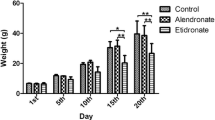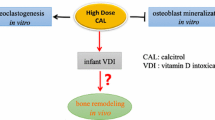Abstract
A 350 mg/kg body weight (b.w.) oral dose of uranyl nitrate (UN) caused 100% mortality in mice three days after administration, due to resulting kidney lesions. Mortality decreased 50% after an oral (o) or subcutaneous (sc) dose of bisodic etidronate (EHBP). Given that bone is also a target organ for uranium (U) in acute intoxication, the aim of this work was to study the effect of exposure to a lethal oral dose of UN on endochondral ossification, and the latter’s response to EHBP treatment. One hundred male Balb/c mice weighing 25 g were assigned to one of ten groups. Group I served as control. Group II received a lethal 350 mg/kg b.w. oral dose of UN by gavage. Groups III, IV, VII, and VIII received an equal dose of UN immediately followed by a single 500 mg/kg oral dose of EHBP in groups III and VII and a single 50 mg/kg subcutaneous dose of EHBP in groups IV and VIII. Groups V and IX only received a single 500 mg/kg oral dose of EHBP, and groups VI and X received a single 50 mg/kg subcutaneous dose of EHBP. The animals in groups II, III, IV, V, and VI were sacrificed 48 h after the onset of the experiment, whereas those in groups VII, VIII, IX, and X were killed at 14 days. Histologic and histomorphometric studies were performed on the femurs to determine growth cartilage width, bone volume, and metaphyseal bone activity. Our results showed that all growth cartilage and metaphyseal bone histomorphometric parameters were significantly lower in animals exposed to UN at 48 h than in controls. EHPB administration was found to prevent this condition at 48 h reaching similar values to those of controls. Although histomorphometric values did not reach control values at 14 days, they were higher than those of animals exposed to UN at 48 h not treated with EHBP. It is noteworthy that these values also decreased in animals only receiving EHBP at 14 days. Our results show that EHBP effectively ameliorates the adverse effects of a lethal dose of UN on endochondral ossification.






Similar content being viewed by others
Notes
Uranyl nitrate hexahydrate [UO2(NO3)26H2O], 98% purity, Merck, Darmstadt, Germany
Ethane-1-hydroxy-1,1-bisphosphonate, 95.7% purity, Gador and Co., Buenos Aires, Argentina
References
Adams N, Spoor NL (1974) Kidney and bone retention functions in the human metabolism of uranium. Phys Med Biol 19:460–471
Au WW, Lane RG, Legator MS, Whorton EB, Wilkinson GS, Gabehart GJ (1995) Biomarker monitoring of a population residing near uranium mining activities. Environ Health Perspect 103:466–470
Cabrini RL, Guglielmotti MB, Ubios AM (1984) Prevention of the toxic effect of uranium on bone formation by tetracycline. Acta Odont Latinoam 1:61–63
Cothern CR, Lappenbusch WL (1983) Occurrence of uranium in drinking water in the US. Health Phys 45:89–99
Díaz Sylvester PL, López R, Ubios AM, Cabrini RL (2002) Exposure to subcutaneously implanted uranium dioxide impairs bone formation. Arch Environ Health 57:320–325
Domingo JL, Llobet JM, Tomás JM, Corbella J (1987) Acute toxicity of uranium in rats and mice. Bull Environ Contam Toxicol 39:168–174
Domingo JL, Ortega A, Llobet JM, Corbella J (1990) Effectiveness of chelation therapy with time after acute uranium intoxication. Fundam Appl Toxicol 14:88–95
Durbin PW, Kullgren B, Xu J, Raymond KN (1994) In vivo chelation of Am (III), Pu (IV), Np (V), and U (IV) in mice by Tren-(ME-3,2-HOPO). Radiat Prot Dosimetry 53:305–09
Durbin PW, Kullgren B, Xu J, Raymond KN (1997) New agents for in vivo chelation of uranium (VI): efficacy and toxicity in mice of multidentate catecholate and hydroxypyridonate ligands. Health Phys 72:865–879
Essien IO, Sandoval DN, Kuroda PK (1985) Deposition of excess amounts of natural U from the atmosphere. Health Phys 48:325–331
Fleisch H (1995) Bisphosphonates in bone disease. From the laboratory to the patient. 2nd Edition. The Parthenon Publishing Group Ltd., England, London, PP 57--61 pp 67
Guglielmotti MB, Ubios AM, de Rey BM, Cabrini RL (1984) Effects of acute intoxication with uranyl nitrate on bone formation. Experientia 40:474–476
Guglielmotti MB, Ubios AM, Cabrini RL (1985) Alveolar wound healing alterations under uranyl nitrate intoxication. J Oral Pathol 14:565–572
Henge-Napoli MH, Archimbaud M, Ansoborlo E, Metivier H, Gourmelon P (1995) Efficacy of 3,4,3-LIHOPO for reducing the retention of uranium in rat after acute administration. Int J Radiat Biol 68:389–393
Hursh JB, Neuman WF, Toribara T, Wilson H, Waterhouse C (1969) Oral ingestion of uranium by man. Health Phys 17:619–621
Hussein EM (1994) Radioactivity of phosphate ore, superphosphate and phosphogypsum in Abu-Zaabal phosphate plant, Egypt. Health Phys 67:280–282
Lapham SC, Millard JB, Samet JM (1989) Health implications of radionuclide levels in cattle raised near U mining and milling facilities in Ambrosia Lake, New Mexico. Health Phys 56:327–340
Martínez AB, Cabrini RL, Ubios AM (2000) Orally administered ethane-1-hydroxy-1,1-bisphosphonate reduces the lethal effect of oral uranium poisoning. Health Phys 78:668–671
Martínez AB, Mandalunis PM, Bozal CB, Cabrini RL, Ubios AM (2003) Renal function in mice poisoned with oral uranium and treated with ethane-1-hydroxy-1,1-bisphosphonate (EHBP). Health Phys 85:343–347
Pujadas Bigi MM, Lemlich L, Mandalunis PM, Ubios AM (2003) Exposure to oral uranyl nitrate delays tooth eruption and development. Health Phys 84:163–169
de Rey BM, Lanfranchi HE, Cabrini RL (1983) Percutaneous absorption of uranium compounds. Environ Res 30:480–491
Ribera D, Labrot F, Tisnerat G, Narbonne JF (1996) Uranium in the environment: occurrence, transfer and biological effects. Rev Environ Contam Toxicol 146:53–89
Stradling GN, Gray SA, Moody JC, Ellender M (1991) Efficacy of tiron for enhancing the excretion of uranium from the rat. Hum Exp Toxicol 10:195–198
Sullivan MF, Ruemmler PS, Ryan JL, Buschbom RL (1986) Influence of oxidizing or reducing agents on gastrointestinal absorption of U, Pu, Am, Cm and Pm by rats. Health Phys 50:223–232
Ubios AM, Guglielmotti MB, Cabrini RL (1990) Ethane 1-hydroxy-1,1-diphosphonate (EHDP) counteracts the inhibitory effect of uranyl nitrate on bone formation. Arch Environ Health 45:376–377
Ubios AM, Guglielmotti MB, Steimetz T, Cabrini RL (1991) Uranium inhibits bone formation in physiologic alveolar bone modeling and remodeling. Environ Res 54:17–23
Ubios AM, Marzorati M, Cabrini RL (1992) Ultrastructural alterations of bone due to uranium intoxication. J Dent Res 71:973 (Abstract)
Ubios AM, Braun EM, Cabrini RL (1994) Lethality due to uranium poisoning is prevented by ethane-1-hydroxy-1,1-bisphosphonate (EHBP). Health Phys 66:540–544
Ubios AM, Braun EM, Cabrini RL (1998) Effect of bisphosphonates on abnormal mandibular growth in rats intoxicated with uranium. Health Phys 75:610–613
Weibel ER, Elias H (eds) (1967) Introduction to stereology and morphology. In: Quantitative methods in morphology. Springer-Verlag, Berlin Heidelberg New York, pp 3–19
Yamamoto T, Masuda K, Nukada K (1971) Studies on environmental contamination by uranium. 6. Uranium in total diet and human urine from non-occupationally exposed persons in Okayama Prefecture. J Radiat Res 13:5
Zamora ML, Tracy BL, Zielinski JM, Meyerhof DP, Moss MA (1998) Chronic ingestion of uranium in drinking water: a study of kidney bioeffects in humans. Toxicol Sci 43:68–77
Acknowledgments
Bisodic etidronate was kindly supplied by Gador and Co., Argentina. This study was partially supported by grants from UBACyT O 013 and PIP CONICET 0499/98. The technical assistance of Ms. Nélida Cuello and Ms. Ana María Gómez is acknowledged.
Author information
Authors and Affiliations
Corresponding author
Rights and permissions
About this article
Cite this article
Bozal, C.B., Martinez, A.B., Cabrini, R.L. et al. Effect of ethane-1-hydroxy-1,1-bisphosphonate (EHBP) on endochondral ossification lesions induced by a lethal oral dose of uranyl nitrate. Arch Toxicol 79, 475–481 (2005). https://doi.org/10.1007/s00204-005-0649-5
Received:
Accepted:
Published:
Issue Date:
DOI: https://doi.org/10.1007/s00204-005-0649-5




